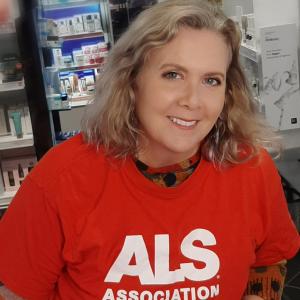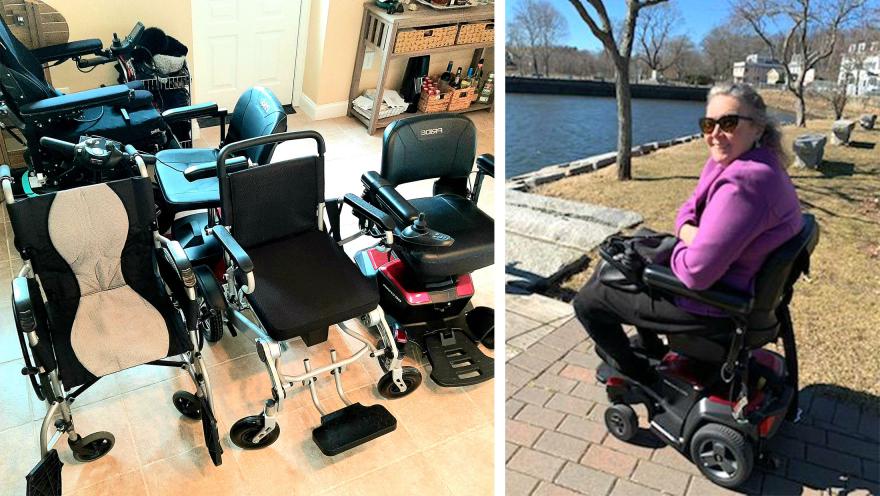By Heidi Tarr Henson
Heidi Tarr Henson, diagnosed with ALS last spring, shares thoughts about her personal journey living with the disease, how she’s managing her personal changes in mobility and how she strives to just live in the moment.
In my kitchen, I have a stockpile of motorized equipment. A Go Chair. A Pride scooter. An electric travel wheelchair that folds like a stroller. A Permobil colossus that I don’t use much yet, unless I need the seat elevation. These take up one half of the room, and I call this section “The Depot.”
The Depot not only houses a stable of vehicles that I can suit to the need, it’s a collection that mirrors my own progression of declining mobility. You know those evolution bumper stickers that start with a fish then move onto a crawling reptile, then an ape, next a neanderthal and eventually to modern man? I feel like I’ve progressed in a similar fashion. First, I just wore an AFO (ankle-foot orthoses) on the right leg where I had foot drop. Then I added a cane for stability, then arm cuff crutches. When those no longer held me up, I got lower leg braces, and transitioned onto a rollator walker. I tried a slew of those before getting the height and stability right. Next it was into a Karma wheelchair, then the Go Chair, a scooter for outside, then the two different motorized chairs now inhabiting my kitchen. I even bought a beach wheelchair. I so miss walking on the beach.
The equipment gives me some security as I ponder how I will keep inhabiting this body. It doesn't feel good, and I don't trust it. I never know whether it's going to move each time I need it to. I want to embrace it, the way I tried to embrace my body at any size. I had always seemed to lose and gain the same 20 pounds. Now, I try to keep weight on, and as my legs, trunk and arms are lacking muscle, I feel like a big ball of skin, with a few bones sticking out.
Sometimes I think I’m living that scene used in so many TV dramas where someone wakes up in a hospital bed and cries “I can't feel my legs!” I can feel my legs enough to feel pain when I inject Vitamin B into my thighs, or when I crash the footpad of my Go Chair into furniture, doors, or baseboards. As this is a frequent occurrence - bad footpad! - my normally purple toes have become scarred and pink. I do feel them. I just can’t move them.
Movement now is like a Wordle puzzle or the dreaded Rubik’s Cube of my youth. When I slip or get wedged in a transfer, I know there is some solution to the problem of my getting upright, but I don’t know it yet. I’m usually unsure of which next move to make. I will try a few maneuvers that (still) work: getting up on my elbows, dragging my long legs up toward me so my feet are flat on a surface, or pulling on the arms of my reclining chair.
I often must reach for something that is just out of range. Pills on my nightstand, lotion on the side table, shoes on the floor. When I need something, I must strategize. Can I lean to the side so as to extend my arm and get it that way? My fingertips may graze the desired object, but often I can’t quite get there. And if I extend too far to the side, I won’t be able to right myself. My trunk muscles have been weakening. If and when my fingers do make contact with the fallen object, I often can’t pick it up because my fingers are weak too.
The tasks I can complete have shrunk drastically in scope and will shrink still. Every time I lift the pitcher of water, a full coffee cup or a plate of food, I hold my breath wondering whether it will slip out of my hands. If it does, it will be a mess someone else is going to have to clean because I likely can’t reach it. Every day, I leave a lot of debris in my wake.
I have experience in being an ailing person, and when I had cancer in my thirties, I started studying Buddhism. I was already familiar with the basic concepts, having gone to a college that required students take philosophy and theology. With cancer and recovery, I knew I needed lessons in detachment, in acceptance and in how to let stuff go.
So, I started attending retreats, taking classes and reading everything by Pema Chodron and Jon Kabat-Zinn. I was never going to become a Buddhist. I ate meat, killed bugs and I certainly was attached to many objects and habits. I didn’t want a guru, or to invest too much in karma as a concept. I’ve seen too many good people suffer and bad deeds go unpunished. I didn’t think bad karma brought on my disease either. So, while I was conflicted on karma, many other concepts in Buddhism resonated with me.
Life is impermanent. Desire and attachment are the root of suffering. Humans always try to avoid pain and hold on to pleasure, which is a fool’s errand. Meditation works, even if you just do a little. And of course, the power of being mindful. Mindfulness has been an approach I call upon to get me through life's more difficult moments, never more so than now. Since my diagnosis last May, I’ve upped my meditation time and as the scope of my life shrinks, I try to be more fully present in each second of it.
Mindfulness comes to bear every day when I try to do something I'm not sure I'm going to be able to do. I might have been able to do it the day before, but now it’s up for grabs. I constantly need to engineer solutions to how I'm going to move from place to place when my arms and shoulders don’t want to cooperate. The legs and feet have been out of the equation for a while.
I’ve learned that I must stop and reflect, be really present, in each moment of asking my body to do something. I need to focus on doing only that. That is enough. No multi-tasking or thinking about what I’m going to have for lunch or what else I should try to accomplish that day. I lock myself into that moment of trying to be mobile. And I make myself be patient. When I just can't seem to move, or I get stuck on a chair, I sit there and wait for a solution to present itself. Sometimes I wait quite a while. When I get down about it, about how my body is failing, and what failures lie ahead, I remind myself.
There is always “The Depot.”
Special thanks to Heidi Tarr Henson for sharing more about her personal journey living with ALS. To continue to follow stories about people living with ALS in the community and learn more about the disease, follow our blog at als.org/blog.

Heidi Tarr Henson has over 30 years of experience in human resources, teaching courses in adult development and organizational behavior, and running a coaching/consulting practice.
Her doctoral dissertation addressed how diversity training can create attitudinal change, and this research was published as an ASTD case study. She published a life transitions guide in 2011.
A native of Cape Ann, Massachusetts, Heidi struggles with giving up ocean rowing, gardening and dancing to live music, and has re-discovered writing and watercolor painting.
She can be reached at mheidichannel@comcast.net.


Join the conversation. Please comment below.